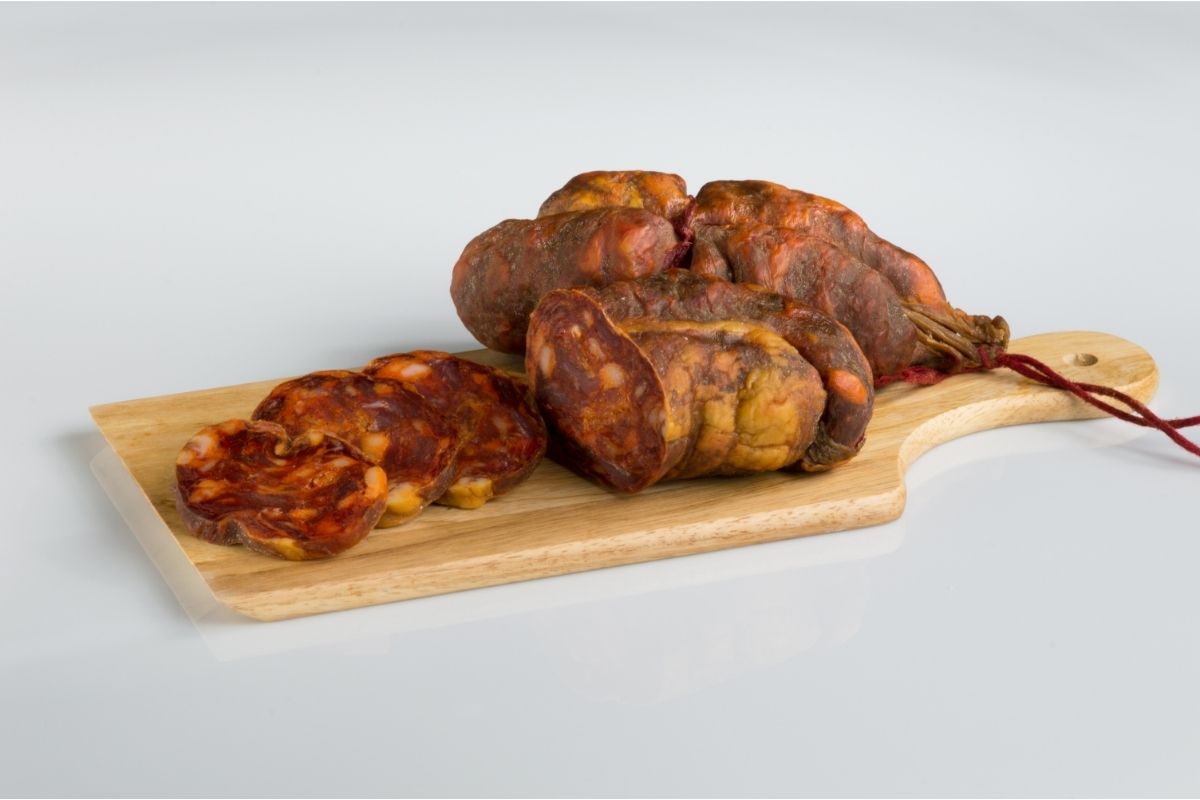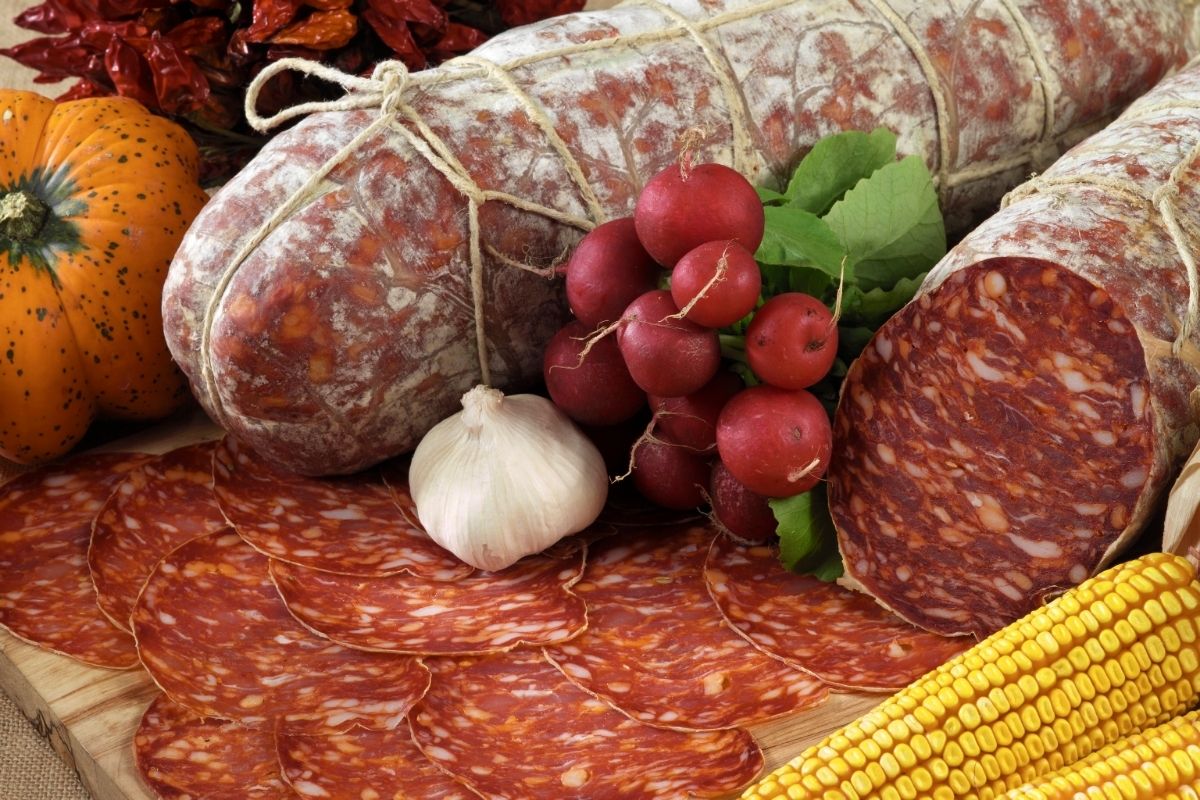What is Italian Sausage?
Italian sausage is a pork sausage with fennel seed or anise seasoning. Fresh or dry herbs will significantly enhance the flavor of your old-school Italian sausage recipe. This is the most common sausage you can find in spaghetti sauces and pizza toppings.
This means that you will have more selections in the market since there are numerous Italian sausages. The seasoning is the only difference between the best Italian sausage and other sausages.
What is Italian Sausage Made of?
Italian sausage is the pork sausage you use in pasta sauces. It is also a sweet (sometimes called mild) Italian variation, with fennel and garlic flavors. Hot Italian sausage has the same ingredients as traditional Italian sausage, plus a little Chile pepper.
Italian sausages come in enormous 6-inch (15.2 centimeters) links, coiled links, and bulk links. It’s patties, not burgers. Cook this sausage thoroughly unless your local Italian butcher store has dried or smoked versions hanging from the rafters. Those are safe to eat raw.
In addition to Italian and breakfast sausages, supermarkets and specialized shops have a wide range of different links such as andouille, banger, and chorizo, as well as hot dogs and cocktail wieners. There are a few essential ingredients that contribute to the flavor of homemade Italian sausage seasoning:
- Parsley
- Seasoning with Italian herbs and spices
- Peppercorns (black pepper)
- Fennel seed is a type of herb that grows in the fennel family.
- Paprika
- Flakes of red pepper
- Salt
- Onion
- Garlic
The Different Types of Italian Sausage
There are numerous additional varieties of Italian sausage available, including:
Salamella
You can make this sausage from pork, veal, lard, spices, and red wine, among other ingredients. You should smoke it to prevent mold growth and then place it in a natural casing to age for several months.
Mortadella
This is a colossal sausage comparable in appearance to Bologna in texture and flavor. You can frequently combine with other ingredients such as pistachios, jalapenos, or olives.

Soppressata
This is a typical Italian pork sausage available in many distinct regional types. In addition, you can make soppressata sausages from coarsely chopped pork meat and fat.
In contrast to the traditional pressed and dried variations found in Basilicata, Apulia, and Calabria, the most prevalent kinds that you can find in Tuscany and Liguria are fresh and available in large, round shapes. This is the opposite of the dry varieties you can find elsewhere in Italy.
Traditionally, salt and pepper are reliable seasonings, but other spices such as pepperoncini or citrus zest are options depending on the region and tradition. This sausage is either Italian beef sausage or pig sausage, depending on the variety. It is available in two forms: uncured and cured in olive oil.
The uncured form is left to dry for 3-12 weeks before you can consume it with crackers or sandwiches.

Nduja
This Italian specialty from Spilinga, Calabria is a cured, chili-seasoned pig salami with a texture similar to that of pâté. You can make it with pork that you have put some chili spice. It is typically wrapped in string and placed in a portion of the hog intestine.
There are various ways to enjoy nduja, including spreading it on grilled, roasted, or seared meat and fish or mixing it into pasta sauces and egg-based recipes. Most people, however, like to spread nduja over grilled or toasted bread and eat it with fresh ricotta or burrata cheese, which they can get from their local market.
This is a pork sausage with a distinct flavor from roast red peppers to the seasoning mix. The spreadability of this sausage makes it stand out from the crowd. you can typically serve it with bread and cheese, or you can use it in pasta sauces as an ingredient
Salami
Salami is a cured sausage that has been fermented and dried in the open air. This sausage may be kept at room temperature for ten years without losing flavor. Salami is available in a variety of flavors, including pepperoni.
Mortadella Bologna
Mortadella Bologna is a traditional Italian sausage that you cook from pig, cubes of fat known as lardelli, and a blend of spices and seasonings. You can trace the origins of mortadella to ancient Bologna, specifically to the Etruscan city of Felsina and the surrounding areas. These areas were rich in oak forests, conducive to the local swine.
Mortadella is closely in line with the pig farming tradition of the Emilia-Romagna region. Even though you can find it throughout Italy’s central and northern areas, the city of Bologna is the official home of this famous sausage.
Ventricina
Ventricina is a well-known Italian cured sausage that you can find in the regions of Abruzzo and Molise, among other places. There are two primary and notably different variants of this Italian delicacy, both produced in the Abruzzo region of Italy.
Ventricina del Vastese in Italy is a complex, cured sausage made with roughly chopped lean pork and spices such as garlic, sweet and spicy pepper, black pepper, and wild fennel seeds. You can serve it thickly sliced on crusty bread.
Ventricina Teramana, on the other hand, is a soft, spreadable version made with fattier sections of pork, lard, garlic, rosemary, fennel seeds, pepperoncini, orange zest, and salt. It is similar to a teriyaki sauce. You can serve it by spreading over slices of fresh bread. You can accompany this with a glass of local red wine.

An Old School Italian Sausage Recipe for You
This recipe for handmade Italian sausage is a huge success for the family! This recipe will guide you on how to make Italian sausage.
Prep time: 30 minutes
Prep time: 30 minutes
Cook time: 12 hours
Total time: 12 hours 30 minutes
Ingredients
- 3 pounds (1.4kilograms) ground pork
- 3 tablespoons red wine vinegar
- 1 tablespoon salt
- 2 tablespoons paprika
- 1 tablespoon freshly cracked black pepper
- 2 tablespoons red pepper flakes crushed
- 1 1/4 tablespoons parsley dried
- 3/4 tablespoon ground fennel seed
- 1 tablespoon garlic powder
- 1/8 tablespoon dried oregano
- 1 tablespoon onion powder
- 1/4 tablespoon brown sugar
- 1 tablespoon dried basil
- 1/8 tablespoon dried thyme
Instructions
- Combine the red wine vinegar and the pork meat in a large mixing bowl.
- You should sprinkle all of the other ingredients on top of it (seasoning, herbs, and vegetables)
- Gently knead the meat, ensuring that you distribute all ingredients uniformly throughout.
- Divide the sausage into three long pieces, wrap each piece in plastic wrap, and place them in a freezer bag before allowing them to cool in the freezer for a couple of hours. You’ll want to store them in a freezer bag to reduce the risk of freezer burn.
- Place the cookies in the freezer for 12 hours before removing them from the freezer.
Nutritional Information
320 calories | 0.008 pounds (4 grams) of carbohydrates | 0.044 pounds (20 grams)of protein | 0.052 pounds (24 grams) of fat | 0.019 pounds (9 grams) of saturated fat.
Who Invented the Sausage?
The Roman Empire adores sausage, but they weren’t the first to create it. In reality, the earliest links were made in Mesopotamia by the Sumerians. This territory closely corresponds to modern-day Iraq, Kuwait, and Saudi Arabia.
The Sumerians were the central culture here. These men claim to have come up with the sausage in 3100BC. It arrived in Turkey in 1000BC. The first reported sausage-making in China was around 580BC. The advent of new spices allowed for the drying and preserving of sausages.
Previously, countries with warmer climates had limited processing and transporting of meat. Therefore, innovating new flavors and sausage types resulted from regional seasonings.
Sausage Inventions Timeline
- Sujuk (1000BC in Turkey): A Turkish food innovation helped things improve by 1000 BC. Sujuk (aka Sucuk) was a dry, spicy beef sausage with sumac, cumin, garlic, pepper, and salt. Then, in various parts of Central Asia, a horse meat Sujuk emerged. It’s still eaten.
- Lap Cheong (580 BC – 300 AD in China): China began manufacturing sausages circa 580 BC. But it was the Lap Cheong that came up around 300 AD and was the winner. Lap Cheong is currently selling worldwide, and various Asian countries have developed their versions.
- Merguez (1300 in North Africa): Around 1300, Northern Africa introduced the Merguez globe, a hot sausage. Due to the hot African climate, this meat was dry. It’s hot mutton or beef sausage with red chilies. Sumac, garlic, and harissa are flavors that make it a flavor explosion. You can find Merguez globally.
- Bratwurst (1313 in Germany): Germany introduced the globe Bratwurst around 1300. A fried pork sausage. It’s a classic German dish that goes well with a beer stein. The texture of a brat is coarser and heavier than a hotdog. But they’re both great on a bun with onions and mustard!
- Mortadella (1376 in Italy): Italians came up with the Mortadella shortly after Germany won with their Brats. It’s a giant pig and lard sausage! You can garnish it with pistachios and olives to add flavor and texture to the dish.
- Frankfurter (1484 in, Germany): Although many think that the Frankfurter comes from Frankfurt, some argue it is from Vienna.
- Chorizo (1600 in Spain): A chili cargo arrived in Spain in 1600. This gave them the ability to manufacture the beloved crimson Chorizo. And now the Chorizo has migrated to neighboring Portugal and Mexico.
- Kielbasa (1800 in Poland): Poland introduced Kielbasa to the world in the 1800s. The best pork sausage ever, with a garlicky taste.Sugar and marjoram are often added to the Polska Kielbasa Wdzona.
May the Wurst be With You!
Do you eat Italian sausages regularly? Would you be interested in knowing how to make Italian sausage? With this homemade Italian sausage seasoning recipe, you can make your Italian pork sausage right in your kitchen.
Combine these flavorful spices with turkey, pork, or beef to make excellent Italian sausage you can use in pizzas, meatballs, spaghetti, or any other Italian dish you can think of.

Community of passionate writers and content creators who share a love for Italian heritage, culture, travel, food, and the Italian-American community. Our mission is to celebrate Italy’s rich history and traditions and connect with others who share the same passion.

